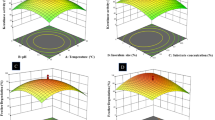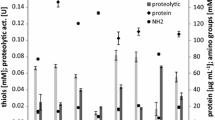Abstract
Feather is the main waste of poultry industries and constitutes of 90% keratin. Wastes composed of keratin are insoluble and recalcitrant to degradation using conventional decomposing methods. Microbial degradation for keratinous wastes is a promising approach for being eco-friendly and economically. However, due to insolubility of keratinous waste, it has several challenges in upstream and downstream processes such as culture medium optimization, designing of bioreactor, bioreaction/flow type, bioreactor configurations considering mass and heat transfer limitations, rheology derived problems, monitoring of microbial activity, choosing of the right scale-up parameter and purification. In this study, the challenges for keratin degradation processes were discussed with the aim of opening new opportunities for keratinous waste treatments in industrial level.

Similar content being viewed by others
References
Kaczmarek B, Nadolna K, Owczarek A (2020) The physical and chemical properties of hydrogels based on natural polymers. Hydrogels based on natural polymers. Elsevier, Amsterdam, pp 151–172
Karthikeyan R, Balaji S, Sehgal P (2007) Industrial applications of keratins–a review. J Sci Ind Res 66:710–715
Onuoha S, Chukwura E (2011) Effect of temperature and pH on bacterial degradation of chicken feather waste (CFW). Int J Sci Nat 2:538–544
Keskin T, Abubackar HN, Arslan K, Azbar N (2019) Biohydrogen production from solid wastes. Biohydrogen. Elsevier, Amsterdam, pp 321–346
Ji Y, Chen J, Lv J, Li Z, Xing L, Ding S (2014) Extraction of keratin with ionic liquids from poultry feather. Sep Purif Technol 132:577–583
Feroz S, Muhammad N, Ranayake J, Dias G (2020) Keratin-based materials for biomedical applications. Bioact Mater 5:496–509
Brown EM, Pandya K, Taylor MM, Liu C-K (2016) Comparison of methods for extraction of keratin from waste wool. Agric Sci 7:670
Gafar A, Khayat ME, Ahmad SA, Yasid NA, Shukor MY (2020) Response surface methodology for the optimization of keratinase production in culture medium containing feathers by Bacillus sp. UPM-AAG1. Catalysts 10:848
Deniz I, Zihnioglu F, Öncel SS, Hames EE, Vardar-Sukan F (2019) Production, purification and characterization of a proteolytic enzyme from Streptomyces sp. 2M21. Biocatal Biotransform 37:377–387
Ningthoujam DS, Tamreihao K, Mukherjee S, Khunjamayum R, Devi LJ, Asem RS (2018) Keratinaceous wastes and their valorization through keratinolytic microorganisms. Keratin. IntechOpen, London
Keskin Gündoğdu T, Deniz I, Çalışkan G, Şahin ES, Azbar N (2016) Experimental design methods for bioengineering applications. Crit Rev Biotechnol 36:368–388
Jeevana Lakshmi P, Kumari Chitturi CM, Lakshmi VV (2013) Efficient degradation of feather by keratinase producing Bacillus sp. Int J Microbiol. https://doi.org/10.1155/2013/608321
Arokiyaraj S, Varghese R, Ahmed BA, Duraipandiyan V, Al-Dhabi N (2019) Optimizing the fermentation conditions and enhanced production of keratinase from Bacillus cereus isolated from halophilic environment. Saudi J Biol Sci 26:378–381
Bagewadi ZK, Mulla SI, Ninnekar HZ (2018) Response surface methodology based optimization of keratinase production from Trichoderma harzianum isolate HZN12 using chicken feather waste and its application in dehairing of hide. J Environ Chem Eng 6:4828–4839
Govarthanan M, Selvankumar T, Selvam K, Sudhakar C, Aroulmoji V, Kamala-Kannan S (2015) Response surface methodology based optimization of keratinase production from alkali-treated feather waste and horn waste using Bacillus sp. MG-MASC-BT. J Ind Eng Chem 27:25–30
Li Q (2019) Progress in microbial degradation of feather waste. Front Microbiol 10:2717
Zhang R-X, Gong J-S, Su C, Qin J, Li H, Li H, Shi J-S, Xu Z-H (2020) Recombinant expression and molecular engineering of the keratinase from Brevibacillus parabrevis for dehairing performance. J Biotechnol 320:57–65
Gong J-S, Ye J-P, Tao L-Y, Su C, Qin J, Zhang Y-Y, Li H, Li H, Xu Z-H, Shi J-S (2020) Efficient keratinase expression via promoter engineering strategies for degradation of feather wastes. Enzyme Microb Technol 137:109550
Peng Z, Zhang J, Du G, Chen J (2019) Keratin waste recycling based on microbial degradation: mechanisms and prospects. ACS Sustain Chem Eng 7:9727–9736
Su C, Gong J-S, Qin J, Li H, Li H, Xu Z-H, Shi J-S (2020) The tale of a versatile enzyme: molecular insights into keratinase for its industrial dissemination. Biotechnol Adv. https://doi.org/10.1016/j.biotechadv.2020.107655
Li Z-W, Liang S, Ke Y, Deng J-J, Zhang M-S, Lu D-L, Li J-Z, Luo X-C (2020) The feather degradation mechanisms of a new Streptomyces sp. isolate SCUT-3. Commun Biol 3:1–13
Akhter M, Wal Marzan L, Akter Y, Shimizu K (2020) Microbial bioremediation of feather waste for keratinase production: an outstanding solution for leather dehairing in tanneries. Microbiol Insights. https://doi.org/10.1177/1178636120913280
Pissuwan D, Suntornsuk W (2001) Production of keratinase by Bacillus sp. FK 28 isolated in Thailand. Agric Nat Resour 35:171–178
Zaghloul TI, Embaby AM, Elmahdy AR (2011) Biodegradation of chicken feathers waste directed by i recombinant cells: scaling up in a laboratory scale fermentor. Bioresour Technol 102:2387–2393
Gameiro M, Lisboa P, Paiva A, Barreiros S, Simoes P (2015) Supercritical carbon dioxide-based integrated continuous extraction of oil from chicken feather meal, and its conversion to biodiesel in a packed-bed enzymatic reactor, at pilot scale. Fuel 153:135–142
Tomaszek JA (2005) Comparison between sequencing batch and continuous flow activated sludge systems. Chemistry for the Protection of the Environment 4. Springer, Boston, pp 275–285
Mazotto AM, Couri S, Damaso MC, Vermelho AB (2013) Degradation of feather waste by Aspergillus niger keratinases: comparison of submerged and solid-state fermentation. Int Biodeterior Biodegrad 85:189–195
Abbasi M, Pazuki G, Raisi A, Baghbanbashi M (2020) Thermophysical and rheological properties of sorbitol+([mmim](MeO)2PO2) ionic liquid solutions: solubility, density and viscosity. Food Chem 320:26566
Gogate PR, Beenackers AA, Pandit AB (2000) Multiple-impeller systems with a special emphasis on bioreactors: a critical review. Biochem Eng J 6:109–144
Marques MP, Cabral JM, Fernandes P (2010) Bioprocess scale-up: quest for the parameters to be used as criterion to move from microreactors to lab-scale. J Chem Technol Biotechnol 85:1184–1198
Van Hecke W, Vandezande P, Claes S, Vangeel S, Beckers H, Diels L, De Wever H (2012) Integrated bioprocess for long-term continuous cultivation of Clostridium acetobutylicum coupled to pervaporation with PDMS composite membranes. Bioresour Technol 111:368–377
Beuker J, Steier A, Wittgens A, Rosenau F, Henkel M, Hausmann R (2016) Integrated foam fractionation for heterologous rhamnolipid production with recombinant Pseudomonas putida in a bioreactor. Amb Express 6:11
Cai C-G, Lou B-G, Zheng X-D (2008) Keratinase production and keratin degradation by a mutant strain of Bacillus subtilis. J Zhejiang Univ Sci B 9:60–67
Author information
Authors and Affiliations
Corresponding author
Additional information
Publisher's Note
Springer Nature remains neutral with regard to jurisdictional claims in published maps and institutional affiliations.
Rights and permissions
About this article
Cite this article
Karaveli, O., Deniz, I. Key Challenges of Microbial Degradation of Keratinous Wastes. Protein J 40, 361–366 (2021). https://doi.org/10.1007/s10930-021-09966-9
Accepted:
Published:
Issue Date:
DOI: https://doi.org/10.1007/s10930-021-09966-9




